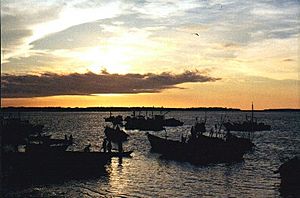Battle of Puná facts for kids
Quick facts for kids Battle of Puná |
|||||||
|---|---|---|---|---|---|---|---|
| Part of the Spanish conquest of Peru | |||||||
 Battle of Puná |
|||||||
|
|||||||
| Belligerents | |||||||
| Puná natives | |||||||
| Commanders and leaders | |||||||
| Francisco Pizarro Hernando Pizarro |
Tumala | ||||||
| Strength | |||||||
| 168 | 3,000 warriors | ||||||
| Casualties and losses | |||||||
| 3-4 dead | |||||||
The Battle of Puná was an important fight during Francisco Pizarro's Spanish conquest of Peru. It happened in April 1531 on Puná, an island near Guayaquil in Ecuador. Pizarro's Spanish soldiers, called conquistadors, won easily. They had better weapons and fighting skills. This battle was the start of Pizarro's third and final trip before the powerful Inca Empire fell.
Contents
Why the Battle Happened
Spanish Arrival in Tumbes
The Spanish army had a very tough journey from Panama. Many soldiers got sick or faced dangers along the way. In April, they finally reached the Inca city of Tumbes. The Inca people there were not very welcoming. They might have heard about the Spanish taking things from other places.
Because it felt unsafe in Tumbes, the Spanish moved their camp. They went to the nearby island of Puná. They planned to attack Tumbes from there.
Life on Puná Island
At first, the Spanish stayed on Puná without any fighting. The people of Puná were strong warriors. They had sometimes been forced to pay tribute to the Inca Empire. But they often fought with the Incas on the mainland.
How the Conflict Started
The path to war began with Pizarro's native interpreters. They told him that some Puná chiefs were planning to rebel. Pizarro captured these chiefs. After questioning them, he seemed sure they were guilty. He then gave them to their old enemies in Tumbes. The Incas there killed the chiefs.
The Battle of Puná
Puná Warriors Attack
Spanish records say that the Puná warriors became very angry. They quickly grabbed their weapons. Thousands of them stormed the Spanish camp. It looked like the small Spanish force would surely be defeated.
Spanish Strength and Strategy
But the Spanish had strong weapons and good training. As the Puná warriors came closer, many ran into sharp pikes. The Spanish were experts at using these long spears. They had learned this in big wars in Italy and Flanders.
Other Puná warriors charged in large, confused groups. Many were shot down by the Spanish musketeers. These soldiers fired their guns in an organized way.
Cavalry Charge and Victory
Soon, Hernando Pizarro saw that the enemy was weakening. He gathered his horsemen. He then led his horses into a charge. The Spanish cavalry cut through the Puná warriors with great force. In just a few minutes, the Puná people were running away.
Aftermath of the Battle
The native warriors regrouped in the island's forests. From there, they fought a guerrilla war. They had some success, destroying Spanish supplies. They also ambushed some Spanish scouts.
However, two Spanish ships soon arrived by sea. They brought more soldiers, led by Hernando de Soto. There were at least a hundred new volunteers. The Spanish then left Puná on these ships. They were heading for more important conquests on the Peruvian mainland. They sailed back towards Tumbes. They arrived there on May 16, 1532.
See also
 In Spanish: Batalla de Puná para niños
In Spanish: Batalla de Puná para niños

